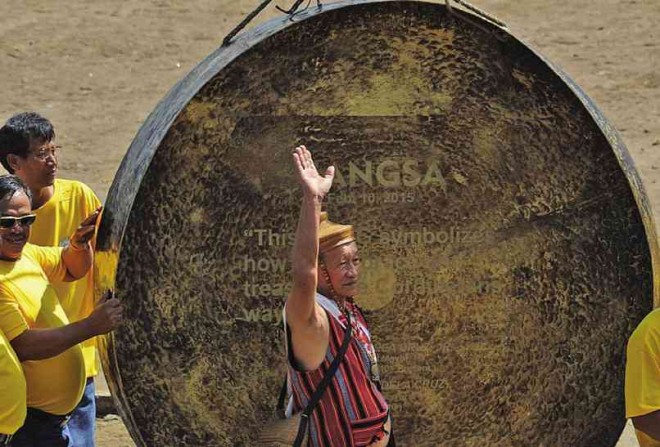
A GIANT gong is one of the main attractions during the Kalinga founding anniversary celebration on Feb. 16 in Tabuk City. EV ESPIRITU
MANILA, Philippines—When residents of seven Kalinga towns and Tabuk City gathered on Feb. 16 to beat 3,048 indigenous gongs, Viel Aquino-Dee, a sister of President Benigno Aquino III, interpreted the resounding din from the instruments as homage to the “Fallen 44,” the Special Action Force commandos killed in a gunfight with Moro rebels in Maguindanao on Jan. 25.
Two of the Fallen 44—Senior Insp. Cyrus Anniban and PO1 Russel Bilog—were from Kalinga, which celebrated its 20th anniversary as a province on Feb. 14 following its separation from Apayao, which also celebrated its independence.
Dee, the event’s guest, said the gongs should also bring “the message of peace to all our countrymen regardless of religion, beliefs and culture.”
This was the second year when residents of Balbalan, Lubuagan, Tanudan, Rizal, Pasil, Pinukpuk and Tinglayan towns, and Tabuk City gathered to play their gongs in the name of peace.
In February last year, the “Awong Chi Gangsa” (Sound of the Gong) broke out from 1,400 gongs which accompanied hundreds of dancers, said Pastor Luis Ao-as, president of the Kalinga-Apayao Religious Sector Association.
“Our gongs ring loud to announce to everyone we celebrate peace and order in our lives and in the rest of the world,” said Dr. Amelia Miranda, who conceptualized the festival. “The ‘gangsa’ is never played when there is grief, when there is conflict and sadness.”
Correcting perception
Organizers said Kalinga decided to celebrate peace for its foundation day to correct people’s perception about the province’s violent past.
Back in the 1990s, newspapers in Baguio City sometimes associated the province with revenge killings whenever crimes there were traced back to a broken peace pact.
Some history books spoke of Kalinga’s headhunting expeditions, which thwarted invaders, including Spanish colonizers and missionaries.
Bodong
Apo Pedro Banguiyac, a 98-year-old “manbatek” (indigenous tattoo artist) of Barangay Lubo in Tanudan, said tattoos used to identify the “mai’ngor” (warrior).
“We became guerrillas in 1944 [when the Japanese Imperial Army occupied the Philippines]. Whenever we engaged the invaders and came home with the head of the enemy, we received the ‘binulibud’ (three parallel lines around the lower and upper arms) and the ‘bikking’ (chest tattoos) for our patriotism,” he said.
But peace now reigns in Kalinga, said Miranda, because it practices the “bodong,” a process to bind various tribes to a peace pact which resolves common disputes, such as those involving boundary or territory and proposed sharing of resources.
The bodong is negotiated by the “pangat” (elders of the contending tribes), who arrive at a consensus.
Bodong was adopted by rebel priest Conrado Balweg and his militia, the Cordillera People’s Liberation Army (CPLA), when they negotiated a ceasefire with then President Corazon Aquino in 1987.
The Cordillera Bodong Administration (CBA), the CPLA’s former political arm, became a unit in the governing bodies of a Cordillera Administrative Region under Executive Order No. 220, which established the upland region in 1987. Reports from EV Espiritu in Kalinga and Vincent Cabreza in Baguio City